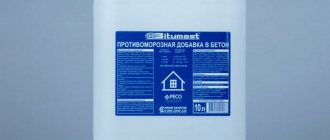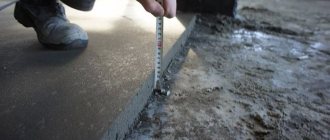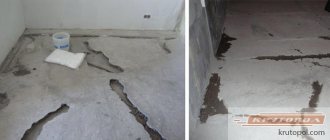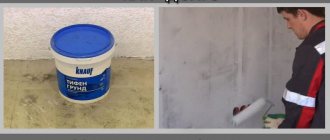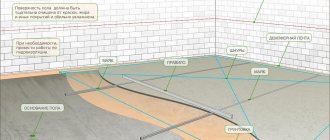Very often, before facing the lower horizontal surfaces, it is necessary to fill the screed to level and strengthen them. It is thanks to it that you can obtain a smooth and reliable base on which tiles, laminate, linoleum or other decorative facing materials will subsequently be laid. If such work is carried out independently, then in order to achieve a high-quality result it is necessary to observe not only the sequence of operations performed, but also the deadlines for their completion. This is due, first of all, to the drying time of the screed. Insufficient drying can cause further deformation and destruction of the structure, and too long a period of time will be inconvenient and disadvantageous for the performer of the work and the owner of the premises. How long a poured floor should dry and when it is permissible to install tiles on it will be discussed below.
Factors affecting screed hardening
Before considering the actual time frame during which the construction mixture poured onto the floor dries, you need to determine what it was made of. There are three types of screeds:
- cement-based;
- gypsum based;
- dry screed.
The fastest drying consistency is obtained on a gypsum basis. However, in practice, when calculating the period of complete drying, experts use a general formula. For both cement and gypsum screeds up to 40 mm thick, the full drying period is calculated based on the fact that one week is needed for every 10 mm of layer. That is, 40 mm should dry for 28 days. This period is also provided for by SNiP for complete hardening of concrete mixtures, especially since according to the technology, the thickness of the cement screed should be from 40 mm.
If, in order to lay tiles, it is necessary to correct surface unevenness of less than 30 mm, then this can be done during the installation process with the tile adhesive itself. This will save on a significant amount of work and will allow you to create a monolithic floor with facing tiles.
If you still had to fill the screed, then its drying is affected
- solution humidity;
- air humidity;
- ambient temperature;
- presence of chemical additives;
- Thickness of the poured layer.
Warm floor
In order to answer how long it takes for a heated floor screed to dry, it is important to determine its time for each type of screed. Usually, when buying a package of the mixture, you can determine how long it will take on average to wait.
Plaster
If we are talking about a gypsum screed whose layer is no higher than 4 cm, then it can set immediately within 4 hours. But it will take about a week to start arranging it and laying the finishing coating. You need to lay ceramic tiles, then start doing this in 4 days.
Plaster
Of course, thicker layers will take more time. Each centimeter takes an average of 42 hours. This is for the first four. Next, the countdown starts at 90 hours for the next centimeter. How long does it take for a 10 cm floor screed to dry? About a month.
How long does it take to lay cement-sand screed in an apartment?
What can be said about the hardening of cement screed for underfloor heating? How thick should it be? How to make a screed in special conditions?
It takes about a week for 4 centimeters to dry, then 15 days are added for each centimeter.
For sand concrete, the drying time is the same. To reduce drying time, use all kinds of additives.
Cement
Thanks to them, the time is reduced significantly. For example, thanks to a proprietary screed, a cement floor can be ready within a few hours.
How long does it take for the dry mixture to harden?
How to make a dry screed, what kind of dry mixture should be prepared, how long will it take for a dry floor screed to dry? Pretty fast. However, while this is convenient, it does have its drawbacks.
For example, the base will not be wet enough, and therefore you cannot lay tiles or laminate on it . What makes dry screed dry so quickly?
Dry
There are several factors that speed up this process:
- converter. Thanks to it, the drainage function is performed. This helps remove moisture from the inner layer faster;
- accelerator. Thanks to it, there is no need to add a lot of liquid to the solution;
- thinner. The consistency of the solution will become even more plastic. This way, not much liquid melts into the solution - it’s not really needed there.
Thanks to these features, it will take just a few days – 3-7 – for the screed to dry completely.
More information can be found on the manufacturer's packaging.
How long does it take for tile screed to dry?
As already mentioned, a standard 40 mm layer will dry completely in four weeks. With greater thickness, each subsequent centimeter will require twice as much time. Therefore, with a thickness of 60 mm, the total drying time will be almost two months. This is due to the difficulty of passing moisture from the lower layers through the dried upper layers.
These terms are taken as conditional and calculated for average air humidity, which should be in the range of 60–70%, and temperature 20–25 degrees Celsius. However, it is not always possible to comply with such standards. After all, in a room where a large floor surface is drying, the humidity will always be higher than in a normal environment. At the same time, it is strictly forbidden to create a draft. On the contrary, it is recommended to forcibly moisten the outer surface of the screed or cover it with film. This is due to the characteristics of building mixtures. When drying, the outer layers harden first, and moisture from the lower ones comes out by soaking the drier zones. If you create conditions for rapid evaporation on some part of the screed, a crust will form, which will seal the damp areas. The exchange of water with the atmosphere will be disrupted. The crust will stop absorbing moisture and will crack. This can often be seen on concrete surfaces.
To prevent this, in addition to moistening and covering, special additives are used to slow down the setting. With such additives, depending on their concentration, the surface will take longer to dry, but the result will be stronger.
The same thing happens with high temperatures. If conditions for strong moisture are not created, then even a reading of 22–25 degrees can cause cracking of the screed surface for the reason described above. Therefore, at high temperatures, forced wetting of drying mixtures is mandatory. This is what the industrial steaming process is based on. Consequently, the drying time of surfaces filled with building compositions can be accelerated by high temperatures with the obligatory moistening of the heated zones.
When working in cold weather, to speed up the drying of mixtures, anti-frost plasticizers are used, which allow the water inside the compositions not to freeze and allow them to fully harden and set.
As can be seen from the above, the exact period for which the screed should dry is difficult to determine. But this is not necessary for laying tiles. Some craftsmen use the old method when they cannot tell by eye whether the concrete is dry or not. They place a napkin on the flooded floor and cover it with plastic. If the paper becomes damp within 24 hours, then the dampness has not completely come out.
Cement stone hydration process
To find out the drying time of the floor screed before facing with decorative materials, you need to clearly understand what processes occur inside the concrete. The main nuances of hydration (formation of high-strength cement stone in a poured volume) are:
- hardening is impossible without a sufficient amount of water, at the same time, 20% of the liquid by weight of dry cement is enough for hydration;
- first, needle-shaped crystals (aluminate structure) are formed in concrete, clinker minerals C2S, C3S (silicate structure) are formed between them;
- then the clinkers are strengthened, on the second day they displace aluminates, on the 28th day the structure consists of 90% silicates;
- It is this time that is considered to be the set of strength of cement stone; its further strengthening lasts for decades.
- the rate of hydration depends on the presence of additives, air temperature, water-cement ratio W/C, cement grinding and the mineral composition of the clinker included in its composition
The process of hydration of cement stone.
In the future, the indicator is influenced by concreting technology:
- to increase workability, 60–75% water by weight of cement is added to wet screeds (W/C = 0.6–0.75, respectively);
- during the formation of cement stone, only 20-25% of the liquid is bound, the rest is distributed in the pores of the structural material, during the transformation of silicate gel into solid stone, shrinkage of the surface occurs;
- chemical reactions inside concrete are accompanied by the release of heat, leading to intense drying of moisture;
- therefore, the surface is additionally moistened in the first 3 days so that the screed does not become covered with shrinkage cracks;
- slaked lime in cement prevents corrosion of reinforcement, gypsum slows down the hydration process, normalizes the structure of cement stone.
Thus, all of these factors should be taken into account in combination to obtain maximum adhesion of the tile adhesive to the concrete base of the floor slab.
How long after pouring surfaces can you start gluing tiles on them?
Experts' opinions on this matter vary. On the one hand, tile adhesive sticks better to a damp surface, and the adhesion process is stronger. Moreover, for the subsequent hardening of the glue itself, it also takes the same time as for drying the screed itself and it will not be possible to use it fully earlier.
On the other hand, the tile will completely preserve all remaining moisture in the poured surface and will not allow it to escape.
Most craftsmen believe that it is possible to correctly lay ceramic tiles in this situation one week after pouring the screed. By this time, 80% of all moisture will have already evaporated, and the process of installing the tiles will take more than one day. While it is being laid on semi-dry concrete, the remaining water will have time to leave it. Moreover, to dry the tile adhesive itself, you will need to delay the grouting for several days. This period of time will be more than enough to complete all the processes occurring in the screed.
The screed is ready for work - how to determine
The readiness of the coating is determined by two points:
- the material for the bundle has already set;
- the coating is ready for any job.
The first stages of processing are carried out almost immediately – within a day. It is important that the entire area is uniform in color and has no deviations. However, avoid placing large objects with enormous weight on the surface.
An experiment to determine whether the treated surface can be loaded can be carried out at least after a week. If you start doing this earlier, the mixture will begin to collapse, and the work will be pointless.
Dry screed
More and more often, craftsmen practice laying tiles without using wet compounds. The ability to install tiles dry opens up great opportunities to simplify and speed up this work. Dry screed consists of fine-grained expanded clay and panels, which are made of two gypsum fiber boards glued together through a layer.
Such kits are good to use on wooden floors, where heavy loads on the main floor cannot be allowed and when working in the cold, since there is no need to work with liquid compounds.
Expanded clay is poured in a layer of 40 mm, and slabs that have locks at the joints can be immediately laid on top of it. This ensures structural rigidity. Despite the apparent flimsiness of such a structure, its strength is quite comparable to plaster or cement pouring. Floor tiles laid on such a surface will last a long time.
Why you can't speed up drying
Setting, allowing movement along the screed, occurs on the first or third day after its installation. The customer often wants to reduce the hardening time, but this is strictly prohibited.
Turned on radiators, heat guns and other heating devices dry the air, resulting in a crust forming on the surface. Under the influence of moisture and steam rising from within, the layer cracks, so work on leveling the floor and preparing it for further finishing must be planned for spring-summer or early autumn, when central heating is not working.
If the upper layers dry too quickly, then moisture may remain in the lower ones. It will be sealed from below with waterproofing, and from above with a dense dried crust. Over time, water can not only tear apart the leveling layer, but also lead to mold.
conclusions
When choosing which screed to make under a floor with tiles, each master will determine from his preferences and the availability of materials. It is only worth noting that drying wet, flooded floors is exactly the case when “you can’t spoil the porridge with oil.” If you have time to wait until the mixture dries completely, then it is better to do this. The dry surface still needs to be treated with primer, and it will be better absorbed if there is no excess dampness in the materials. In addition, on completely dried layers of building mixtures, possible cracks will be visible, which can be repaired before laying the tiles. And if the screed is weak somewhere, it will be possible to lay a metal mesh on these areas when gluing the tiles to give additional rigidity to the floor.
Types of screeds by consistency
According to their consistency, they are usually divided into:
- wet (raw);
- semi-dry;
- quick-drying.
Each of them has different installation technologies, methods of preparing the working solution and drying time. The time it takes to complete the final flooring processes depends on this time. How long does it take for tile screed to dry? Let's consider this issue in more detail.
What determines the drying speed of a floor screed?
In order for drying to occur as correctly as possible, and for the resulting strength to correspond to that declared by the manufacturer, it is necessary to create ideal conditions for drying. The parameters are usually indicated on the packaging.
Air humidity
It would seem that in order for something to dry faster, you need to place it in dry conditions. This has nothing to do with the screed. If you artificially speed up the drying process, there is a risk of getting a leveling layer with cracks.
Optimal humidity conditions are 60-70%.
If the values are below normal, it is necessary to protect the floor screed from drying out too quickly. To do this, after setting, the composition is covered with plastic film for 7-10 days. Later, they are kept for another 2-3 weeks under sawdust or sand, which is constantly moistened. Further, until complete hardening, protective coatings are not used, but in very dry conditions, spraying the leveling layer is allowed.
Thickness
The key factor influencing the rate of hardening of the screed is its thickness.
This indicator is different for different types of mixtures. The standard calculation value is the drying rate of each centimeter of screed with a total leveling thickness of 40 mm. If the base has many significant defects (chips, deviations from the level and protrusions that cannot be eliminated), a thicker leveling layer may be required. In this situation, every centimeter of excess of the standard thickness requires more drying time.
The thickness of the layer is taken into account not as the average, but as the maximum for the fill.
Drying time is calculated depending on the thickness of the leveling layer; the most commonly used cement screed can be taken as an example.
Drying time for every 10 mm is 7 days. Provided its total thickness is within 4 cm. If this figure is higher, then each centimeter of excess will require 2 weeks to harden.
So a three-centimeter floor screed will dry for 21 days, a five-centimeter one - 43, and a layer 10 cm thick will require a technological break lasting 112 days, almost 4 months.
Based on similar calculations, the technical and economic parameters of various screed installation options are compared and a material for its manufacture is selected that is acceptable in terms of price and drying period, that is, a forced break in work.
Temperature
The optimal temperature for drying the screed is 20-25°C; at lower temperatures the process slows down. At higher rates, it accelerates excessively, which adversely affects its quality. When the thermometer drops below 5°C, work on laying the leveling layer of the floor must be stopped, or special additives must be used to prevent freezing of the wet composition.
During the ripening process (complete drying and completion of chemical processes), the screed must be protected from exposure to direct sunlight, sudden changes in humidity and temperature.
Fillers for screed
The use of special additives, such as fillers and plasticizers, makes it possible to reduce the drying time of the leveling layer without losing its strength characteristics.
Fillers are substances that are added to a building mixture to give it the necessary performance characteristics. When added to the composition, they do not dissolve, but fill the volume. Fiber (short fibers made of metal, basalt or glass fiber), expanded clay, and polystyrene granules are used as fillers. By introducing them into the floor leveling composition, it is possible to reduce the amount of water required for mixing by 40-50%. Accordingly, it will take less time to evaporate moisture, while the mixture will harden under natural conditions, and all chemical processes in the thickness of the screed will occur as needed to gain strength.
The use of fillers also speeds up the setting process, that is, you can start walking on the floor about 2 times earlier (about 12 hours).
Adding plasticizers to the mixture to prepare the base for finishing helps to liquefy it, but this does not affect the final strength indicators. A more plastic mixture fills unevenness more easily, and less screed layer will be required.
A number of plasticizers promote slower setting of the top layer. Moisture rises to it and evaporates faster, since the process is not slowed down by a crust on the surface.
The use of special additives must be in strict accordance with the manufacturers' recommendations. Otherwise, there is a risk of obtaining a mixture with low strength characteristics.
Quality of base waterproofing
When installing floor coverings, it is necessary to carefully monitor the quality of waterproofing. You should not save money and use polyethylene film for this purpose, which is destroyed over time under the influence of cement. Waterproofing should be done using roll materials or bitumen mastics.
In the first case, the rows are laid with an overlap of 15-20 cm, and their joints are coated with waterproofing mastic, and they should extend onto the walls by 20-25 cm. After the screed has completely dried, the excess can be carefully cut off.
When using coating waterproofing, it is applied without gaps not only to the floor, but also to the lower part of the walls in 2 layers.
Poorly performed waterproofing will result in moisture from the base beginning to penetrate into the screed under the influence of capillary tension. This is especially dangerous for floors located above unheated, damp rooms, or monolithic foundations located directly on the ground. This will significantly increase the drying time. And the already hardened screed will collapse, becoming saturated with moisture, which will lead to peeling and destruction of the finish coating.
Also, defects in the protective layer contribute to the formation of condensation directly inside the screed.
What determines drying time?
When starting a renovation, you need to calculate not only the amount of materials, but also the time to complete the work. This approach will ensure a truly high-quality result and your efforts will not be in vain. The longest stage in floor repair is the maturation of the screed, and there are certain factors that can either shorten or increase this period.
What determines drying time?
The drying of the cement screed is affected by:
- humidity and temperature conditions of the room in which the work is performed;
- thickness and number of layers of cement mortar;
- the presence of fillers in the screed;
- quality of base waterproofing.
Beginning craftsmen often confuse the setting time of the mixture and the drying time. Yes, after a day you can safely walk on the floor without leaving marks, and after a week the surface seems quite durable. But in the pores of the cement layer there remains a lot of water that needs to escape. Since waterproofing is laid under the screed, water can only escape to the surface of the base, therefore, if the coating is laid too early, it will become damp and deformed. And even a week or two after filling there is still a lot of moisture inside.
Flooring laid on a damp screed may become deformed.
The standard drying time for cement screed is indicated within 28 days, but for this, each of the above factors must meet the standard.
Air humidity
Recommended indoor humidity should be between 40 - 60%
The recommended indoor humidity is 60-70%; if this indicator is lower, the water will evaporate too quickly and cracks will form on the surface. At high humidity, the drying time of the solution will significantly increase. If the humidity is less than 60%, you can regulate the process of water evaporation using plastic film, covering the work surface after the solution has set.
Temperature
The optimal temperature for drying any screed is considered to be +20-25 °C. At a higher value, the top layer begins to crack; at a low value, it takes longer to dry. Please note that both the room temperature and humidity must remain stable throughout the drying period, so be sure to exclude any air currents, direct sunlight, or heating the room with heating devices.
If the screed is being carried out in a new building where there is no heating yet, the solution must be poured at least 1.5 months before the onset of cold weather. Freezing of an unripened screed leads to its destruction throughout its entire thickness. You can use special plasticizer additives that give the solution frost resistance, but this will increase repair costs.
Plasticizer for all types of concrete
Thickness and number of layers
Subject to temperature conditions, a 10 mm thick layer of cement mortar dries completely in 7 days. The standard thickness of the cement screed is 40 mm, which means it will take 28 days to dry. But if the layer thickness exceeds 40 mm, for each additional centimeter you need to add not 7, but 10-15 days. That is, a screed with a thickness of 60-80 mm will dry for about 2-3 months.
Floor screed: diagram
If a thick screed is required to level the base, you can reduce the drying time by pouring the solution in several layers. For example, first the screed is poured so as to cover the deep recesses on the base, and after this layer has dried, another one is poured, which will cover the protruding areas and form a zero level.

